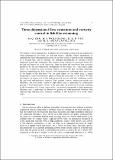Three-dimensional flow structures and vorticity control in fish-like swimming
Author(s)
Zhu, Q.; Wolfgang, M.J.; Yue, D.K.P.; Triantafyllou, M.S.
DownloadTriantafyllou_2002_Three.pdf (891.1Kb)
Terms of use
Metadata
Show full item recordAbstract
We employ a three-dimensional, nonlinear inviscid numerical method, in conjunction
with experimental data from live fish and from a fish-like robotic mechanism, to
establish the three-dimensional features of the flow around a fish-like body swimming
in a straight line, and to identify the principal mechanisms of vorticity control
employed in fish-like swimming. The computations contain no structural model for
the fish and hence no recoil correction. First, we show the near-body flow structure
produced by the travelling-wave undulations of the bodies of a tuna and a giant
danio. As revealed in cross-sectional planes, for tuna the flow contains dominant
features resembling the flow around a two-dimensional oscillating plate over most
of the length of the fish body. For the giant danio, on the other hand, a mixed
longitudinal-transverse structure appears along the hind part of the body. We also
investigate the interaction of the body-generated vortices with the oscillating caudal
fin and with tail-generated vorticity. Two distinct vorticity interaction modes are
identified: the first mode results in high thrust and is generated by constructive
pairing of body-generated vorticity with same-sign tail-generated vorticity, resulting
in the formation of a strong thrust wake; the second corresponds to high propulsive
efficiency and is generated by destructive pairing of body-generated vorticity with
opposite-sign tail-generated vorticity, resulting in the formation of a weak thrust
wake.
Date issued
2002Department
Massachusetts Institute of Technology. Department of Mechanical EngineeringPublisher
Cambridge University Press
Citation
Journal of Fluid Mechanics, 468, p.1-28 (2002)
Keywords
flow structures, vorticity control, fish-like